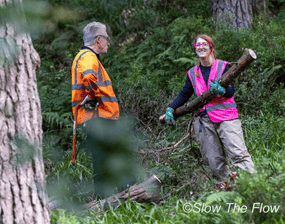Rising waters | Rooted solutions
Living Labs update: exploring trees, wellbeing and NFM

Living Labs let students apply their research skills to NFM topics, exploring tree cover to community wellbeing, revealing overlooked insights for Ousewem and wider flood risk management.
This year’s Living Labs are already making a difference. Two MSc students from the University of York have spent the summer diving into real-world natural flood management (NFM) challenges, helping us strengthen the evidence base for future decisions and policy.
Coordinated by Professor Piran White, the Living Labs offer students the chance to apply their research skills to NFM questions with practical implications for the Ousewem project and beyond. From tree cover to community wellbeing, their work is shedding light on areas that are often overlooked in flood risk management conversations.
How trees and woodland help reduce flood risk
Matilda Finch has been adapting a plant physiology model to understand the role of woodland in flood mitigation. Her project focuses on evapotranspiration - how much water trees return to the atmosphere - and how this affects peak river flows.
She’s been busy compiling weather data from the Met Office and vegetation data for an upland site in the Ousewem catchment. Next, she’ll compare the model’s outputs with real-world measurements to validate the approach. She will then test how different tree species influence evapotranspiration, giving us new insight into the value of woodland and hedgerow planting as NFM tools.
Her findings will support the Ousewem team in identifying which tree species offer the most potential for reducing flood risk, helping inform future land management decisions.
NFM and mental health: early evidence from community volunteers
Amelia Czop has been exploring how NFM can also improve mental health and wellbeing. Alongside reviewing existing literature, she’s carried out interviews with Slow the Flow volunteers in Hebden Bridge, gathering first-hand insights on how participation in NFM projects impacts people’s lives.
So far, her findings suggest that working on NFM projects has real mental health benefits. Volunteers describe the positive effects of being active outdoors, doing something meaningful with others, and seeing the results of their efforts in the landscape.
Her work also highlights the role that community-led NFM plays in building social connections and strengthening local resilience - all of which support wider priorities around health, climate and the economy. This will be some of the first UK-based data connecting NFM to wellbeing outcomes and will help us make the case for community involvement in future schemes.
Looking ahead: more Living Labs to come
Both projects are due to wrap up in September. Their work will help deepen our understanding of NFM’s multiple benefits and open up new areas for research.
We’re now looking for a new cohort of undergraduate and postgraduate students to join us through the Living Labs programme for the coming academic year. Whether your interests lie in environmental science, geography, health, or community engagement, we’re keen to hear from you.
Interested in joining the next Living Labs?
Interested in joining the next Living Labs? Interested 2025 students are asked to contact the University of York Living Labs lead, Professor Piran White, via email: [email protected].
Also see

